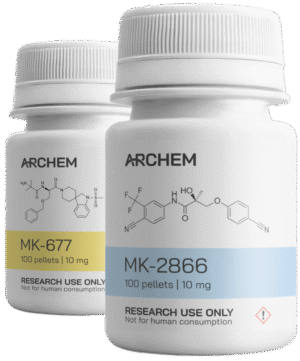
Gynecomastia—the non-cancerous growth of male breast tissue—happens when there’s an imbalance between estrogen and androgen levels. SARMs (Selective Androgen Receptor Modulators) are designed to activate androgen receptors mainly in muscle and bone, but they can still shake up your hormones in ways that raise questions about their role in causing gynecomastia.
How SARMs Work (And Why Hormones Matter)

SARMs are synthetic compounds that bind to androgen receptors, helping boost muscle and bone growth. Unlike regular anabolic steroids, SARMs don’t get converted into estrogen through a process called aromatization. This should, in theory, mean they’re less likely to cause estrogen-driven side effects like gynecomastia.
But the body’s hormone system is a lot more complicated than it looks. When you start messing with it, even if you’re targeting one thing, other unexpected changes can happen.
How SARMs Could Still Lead to Gynecomastia
1. Testosterone Suppression
SARMs can shut down parts of your hormone system—specifically the hypothalamic-pituitary-gonadal (HPG) axis. This lowers the production of key hormones like LH and FSH, which in turn drops your natural testosterone levels. With less testosterone around, estrogen can take the upper hand, leading to breast tissue growth.
2. Changes in Estrogen Activity
Even though SARMs don’t directly turn into estrogen, lowering testosterone can change how estrogen acts in your body. Less competition at the receptor level can make estrogen’s effects more noticeable, especially in breast tissue. MK677 does not appear to present this effect.
3. Individual Differences
Not everyone’s body reacts the same way. Your genetics and how sensitive your tissues are to hormones can make you more—or less—likely to develop gynecomastia when using SARMs.
Real-World Evidence
There’s a documented case of a 40-year-old man who developed gynecomastia after using SARMs, even though his testicles were normal and he didn’t have any major health issues. Cases like this show that while the risk may be lower than with steroids, it’s not zero.
SARMs vs Steroids: A Quick Look
| Feature | SARMs | Steroids (AAS) |
|---|---|---|
| Aromatization | No | Yes |
| Estrogenic Side Effects | Lower risk | Higher risk |
| HPG Axis Suppression | Moderate | Significant |
| Gynecomastia Incidence | Less common | More common |
SARMs such as Ostarine do have a better side-effect profile compared to traditional steroids, but the chance of getting gynecomastia still exists.
The Chemist’s View By John Harling

On paper, Selective Androgen Receptor Modulators (SARMs) seem chemically clever: designed to enhance muscle and bone selectively, without directly morphing into estrogen, that pesky hormone behind breast enlargement (gynecomastia).
Yet, chemistry—much like life—is rarely that straightforward.
Imagine your endocrine system as an orchestra. Testosterone and estrogen are its key players, keeping harmony between masculinity and femininity in perfect balance. SARMs enter the picture as an unexpected conductor, selectively cueing androgen receptors in certain tissues. However, when your body senses this artificial “boost,” it starts whispering back to the brain: “Enough testosterone already!” Consequently, your natural testosterone production drops—dramatically at times.
Now, here’s the plot twist: less testosterone doesn’t merely lower androgenic activity; it inadvertently rolls out the red carpet for estrogen.
Even though SARMs themselves don’t directly convert into estrogen, this hormonal shift lets existing estrogen roam freely, amplifying its effects, especially in sensitive tissues like breast glands. Add in local enzymes, such as aromatase, that convert even tiny amounts of remaining testosterone into estrogen within breast tissue itself, and you suddenly have the perfect biochemical storm.
References
Selective Androgen Receptor Modulators: The Future of Androgen Therapy. Translational Andrology and Urology. LinkTranslational Andrology and Urology
Reversible Gynecomastia and Hypogonadism Due to Usage of SARMs. National Center for Biotechnology Information. LinkPMC+1PMC+1
The Role of Androgens in Normal and Malignant Breast Tissue. PubMed. LinkPubMed
Selective Androgen Receptor Modulators. Wikipedia. LinkWikipedia
Recreational Use of Selective Androgen Receptor Modulators. U.S. Pharmacist. LinkUS Pharmacist
